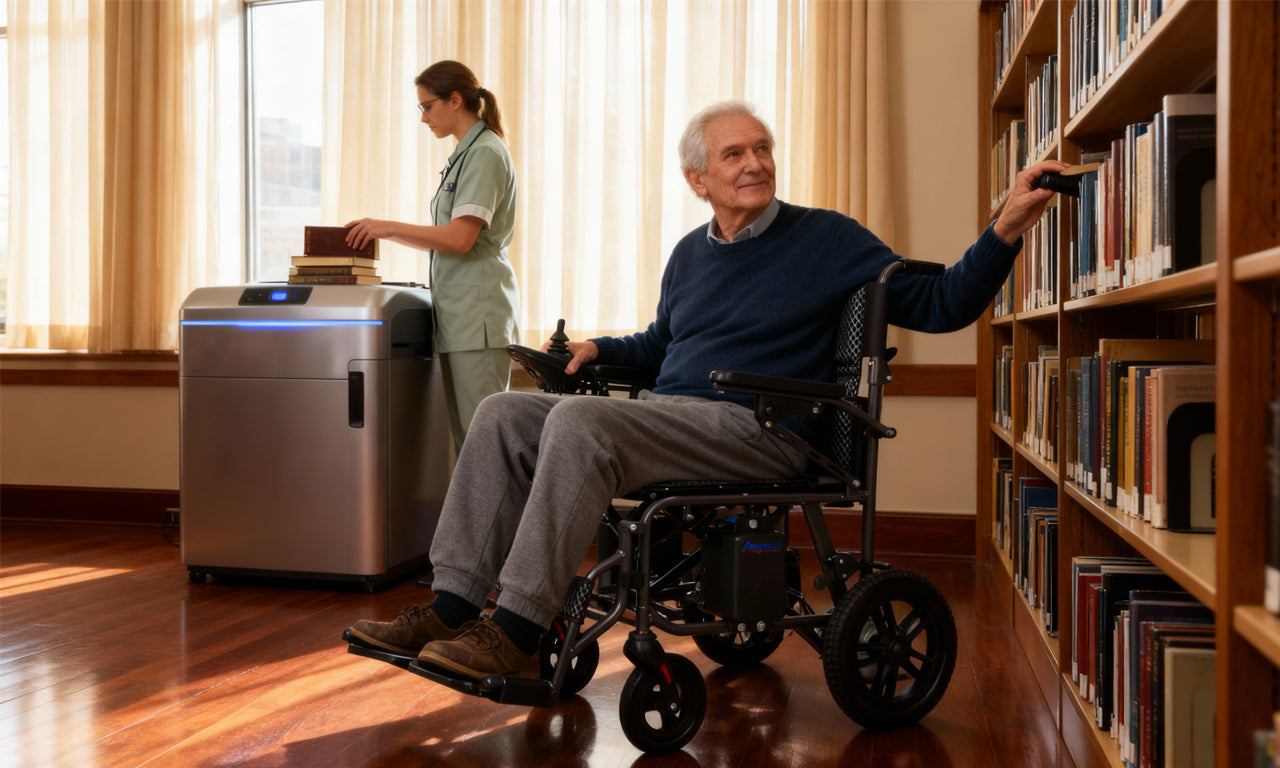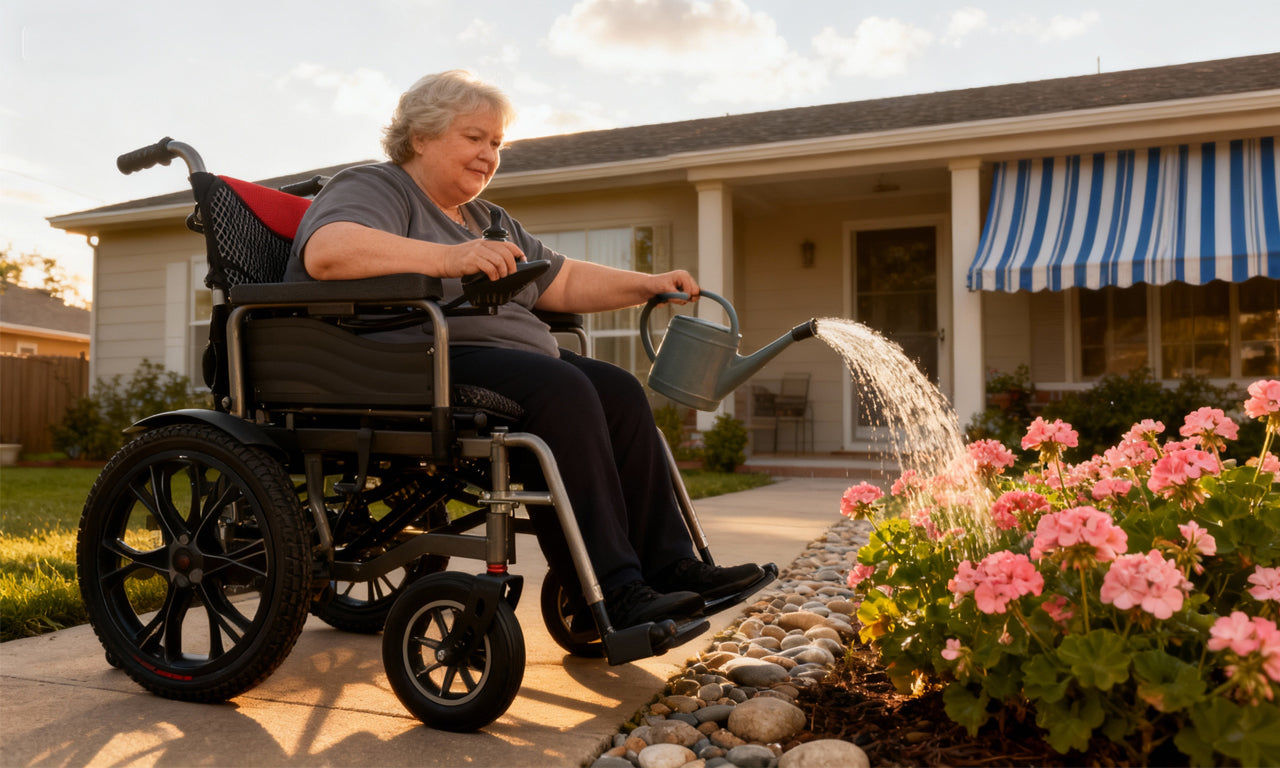Introduction
When considering an electric wheelchair, one of the most important questions potential buyers ask is: how many hours does an electric wheelchair last on a single charge? Understanding the battery life of an electric wheelchair is crucial not only for daily mobility but also for long trips, outdoor activities, or healthcare needs.
In this guide, we will explore the factors that affect battery life, compare different wheelchair types, offer real-world usage scenarios, and introduce the Anywell YS16-1 as a recommended option for those seeking reliability, comfort, and long-lasting performance.
Understanding Electric Wheelchair Battery Life
Electric wheelchairs typically rely on two main types of batteries: lead-acid and lithium-ion.
- Lead-acid batteries are heavier and have shorter lifespan, usually lasting 1.5–3 hours under continuous usage. They are more affordable but require regular maintenance.
- Lithium-ion batteries, on the other hand, are lightweight, last longer, and can provide 3–6 hours of continuous operation depending on the model. These batteries are commonly found in modern, high-performance models like the Anywell YS16-1.
It is important to note that manufacturer specifications are usually based on ideal testing conditions. Actual usage hours may vary depending on the user’s weight, terrain, speed, and environmental factors.
Key Factors Affecting How Long an Electric Wheelchair Lasts
Several factors determine how long an electric wheelchair can operate on a single charge:
1. Battery Capacity
The larger the battery (measured in ampere-hours, Ah), the longer the wheelchair can run. For instance, the Anywell YS16-1 is equipped with a high-capacity lithium battery that supports 16 km of travel, roughly translating to 4–5 hours of continuous use under normal conditions.
2. User Weight
The battery must work harder when carrying heavier loads. Heavier users may see reduced operating hours. Heavy-duty models designed for obese users, such as Anywell YS16-1, are optimized to maintain consistent performance even for users up to 150 kg.
3. Terrain and Slope
Smooth indoor surfaces allow wheelchairs to maximize battery life. Outdoor terrains, hills, or uneven surfaces increase energy consumption. The Anywell YS16-1 can easily navigate slopes up to 9°, maintaining stable power efficiency.
4. Speed Settings
Higher speeds consume more battery power. Most wheelchairs allow users to adjust speed to balance performance and battery life. Using moderate speed can significantly extend the hours of operation.
5. Wheelchair Model & Efficiency
Different models have varying motor efficiency, weight distribution, and design. Lightweight foldable electric wheelchairs often consume less energy, while heavy-duty or wider models require more power. The Anywell YS16-1 combines ergonomic design, lightweight aluminum alloy frame, and high-efficiency dual motors to provide optimal battery life.
Average Hours of Usage for Different Wheelchair Types
Lightweight Foldable Electric Wheelchairs
- Typical usage: 3–4 hours
- Pros: Easy to transport, ideal for short trips and travel
- Cons: Limited range for outdoor activities

Wide or Heavy-Duty Electric Wheelchairs
- Typical usage: 3–5 hours
- Pros: Stable, comfortable for larger users, higher weight capacity
- Example: Anywell YS16-1, designed for obese users, offers a wide, ergonomic seat and enhanced power efficiency
Transportable Electric Wheelchairs
- Typical usage: 3–4 hours
- Pros: Foldable, easy to store, FDA-approved models like Anywell YS16-1 ensure safety and quality
Tips to Extend Electric Wheelchair Battery Life
- Charge Properly: Avoid letting the battery drop to 0% and recharge regularly.
- Avoid Overuse on Slopes: Excessive uphill travel drains batteries faster.
- Perform Regular Maintenance: Clean battery terminals and check for wear.
- Store Correctly: Keep the battery at moderate temperature; avoid extreme cold or heat.
Real-World Examples: How Many Hours Can You Expect?
- Daily Indoor Use: 3–4 hours for light commutes, shopping, or home mobility
- Outdoor Activities: 2–3.5 hours depending on terrain and slope
- Healthcare or Continuous Use: Using dual battery or high-capacity models, such as the Anywell YS16-1, can sustain 4–5 hours of operation for long outings or trips
Why Anywell YS16-1 Is Recommended
The Anywell YS16-1 stands out as a top choice for users concerned about battery life, comfort, and reliability:
- Battery & Duration: 16 km range, approximately 4–5 hours continuous use
- Affordability: Market-leading price at $699
- Power & Terrain Capability: Dual motors, easily climbs 9° slopes
- Ergonomic Comfort: Extra-wide, breathable, ergonomically designed seat for extended use
- Portability: Light foldable design for easy storage and travel
- Certifications: FDA-approved for safety and quality assurance
The Anywell YS16-1 combines long-lasting performance with user-focused design, making it ideal for seniors, frequent travelers, and heavy-duty users.
Conclusion
Understanding how many hours an electric wheelchair lasts helps users plan daily activities, travel, and healthcare routines. Battery life depends on multiple factors, including battery type, terrain, weight, and speed settings.
Choosing a reliable, high-performance wheelchair like the Anywell YS16-1 ensures longer operating hours, ergonomic comfort, and safety. With proper care and charging habits, users can maximize the lifespan and usability of their electric wheelchairs.
FAQ: Electric Wheelchair Battery Life
- How many hours does an electric wheelchair battery last on average?Typically 3–5 hours depending on model and usage; Anywell YS16-1 can last up to 4–5 hours.
- Typically 3–5 hours depending on model and usage; Anywell YS16-1 can last up to 4–5 hours.
- Does user weight affect battery life?Yes, heavier users consume more battery power; heavy-duty wheelchairs like Anywell YS16-1 are optimized for up to 150 kg.
- Yes, heavier users consume more battery power; heavy-duty wheelchairs like Anywell YS16-1 are optimized for up to 150 kg.
- Can terrain reduce wheelchair operating hours?Yes, slopes and uneven terrain increase energy consumption.
- Yes, slopes and uneven terrain increase energy consumption.
- How can I extend my wheelchair’s battery life?Charge regularly, avoid extreme slopes, maintain the battery, and store properly.
- Charge regularly, avoid extreme slopes, maintain the battery, and store properly.
- Is the Anywell YS16-1 suitable for outdoor use?Yes, it handles indoor and outdoor terrains, climbs slopes up to 9°, and has long-range performance.
- Yes, it handles indoor and outdoor terrains, climbs slopes up to 9°, and has long-range performance.
Recommended Reading
1. In‑Depth Review of the Anywell Heavy Duty Electric Wheelchair: Light as Air, Strong as a Mountain
2. Portable Mobility Device: Finding the Right Fit for Your Lifestyle
3. Portable Mobility Device: Finding the Right Fit for Your Lifestyle






Leave a comment
This site is protected by hCaptcha and the hCaptcha Privacy Policy and Terms of Service apply.